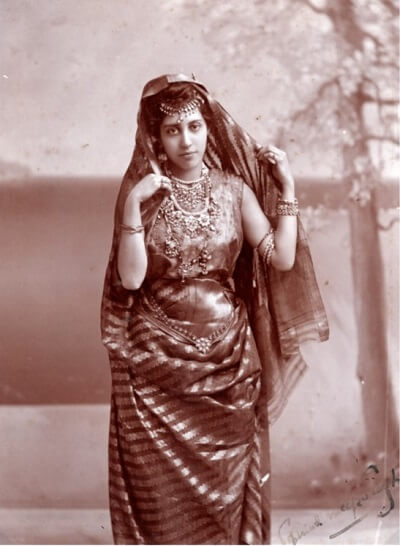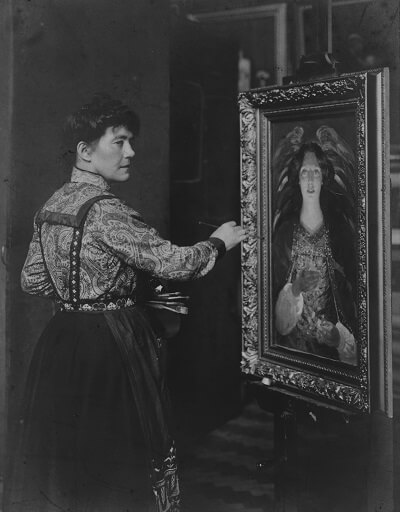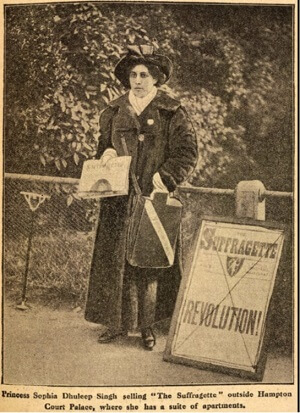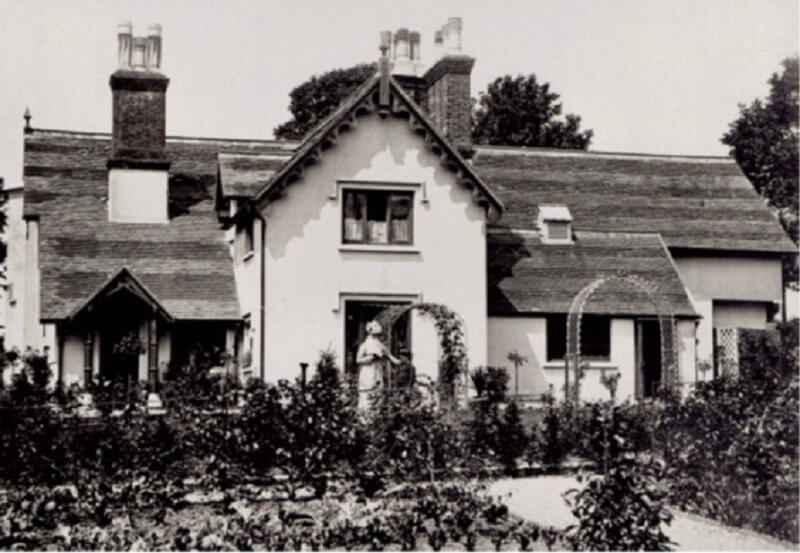Louise Jopling’s banner for Actresses’ Franchise League, 1911, courtesy of the Women’s Library @LSE
By Alison Bailey

The Sikh Princess Sophia Duleep Singh lived in Penn after WWI. She was a radical suffragette, and most likely moved to Penn to be near to friends she had made whilst campaigning for women’s suffrage as there was a group of active suffragettes who settled in the village including Louisa Garrett Anderson, Flora Murray and Muriel Matters. She was also a friend of the celebrity portrait painter, Louise Jopling, add link who lived in Chesham Bois.
As committed suffragettes they had campaigned together at London branches of Emmeline Pankhurst’s Women’s Social and Political Union (WSPU) and were both active in the highly effective Tax Resistance League (TRL).
The Tax Resistance League
The motto of the League was ‘No Vote No Tax’ and, as a protest against their unfranchised status, members consistently refused to pay taxes. They were prepared to go to prison for such serious crimes as keeping a dog without a licence, as happened to Emma Sproson, a suffragette from West Bromwich!

The Princess was Queen Victoria’s goddaughter and lived in Faraday House, a ‘grace and favour’ residence, at Hampton Court. She had her own income and did not have to earn money. However, the Princess still had to pay tax and repeatedly declined to do so. Louise Jopling had been earning her own living as an artist from the 1860s when she was abandoned by her first husband, Francis Romer. She also ran a successful business, an art school for women and had published several books. She strongly resented that she had to declare her income to her husband, who paid taxes on her behalf, but as she had no vote, she had no say in how these taxes were spent.
In 1911 the Princess’s refusal to pay 6s in arrears for licences for her five dogs, her carriage, and her manservant, led to a seven stone diamond ring being impounded by bailiffs. The ring, which was presumably far more valuable than the taxes due, was to be sold at Hick’s Auction Rooms in Ashford, Kent on July 25. The TRL immediately mobilised and summoned its members: “Meeting to be held in Auction Rooms after sale. Please come and bring friends to support Protest Meeting at 4 o’clock”.
The Auction
As the Princess’s suffrage activities were widely reported in the press, much to the embarrassment of the Royal Family, the auction sale was guaranteed to generate great publicity for the cause. July 27, 1911 the Bath Chronicle reported that “the princess, who was supported by many members of the League, made a protest against the sale, but the auctioneer intimated that it must proceed. Bidding commenced at £5 and went up to £10, at which price the ring was secured by Mrs Jobling (their spelling) Rowe, who subsequently, on behalf of the League, returned it to the princess. Mrs Cobden Sanderson afterwards addressed a protest meeting held in the auction room”.
Louise Jopling, who after her third marriage became Mrs Jopling Rowe, was indeed one of the League members at the sale. Smartly dressed, with presumably a large hat, her role was to intimidate the other customers to ensure her bid was successful, so that the ring could be presented back to the Princess with maximum ceremony.
Princess Sophia Duleep Singh
The Princess was the daughter of the deposed Maharaja Duleep Singh, the last Maharaja of the Sikh Empire and, with her sisters, grew up amongst the British aristocracy. A great beauty, she was frequently in the press as a fashion icon and celebrity socialite. After her social conscience was awakened following a visit to India, she became a militant suffragette.

In addition to campaigning for the TRL, the Princess was a major donor to the WSPU. An active campaigner for the Richmond Branch, she drove round London in a press cart selling The Suffragette and illegally defaced her census paper in 1911. On another occasion she threw herself, and her Votes for Women placard, at Prime Minister Asquith’s car.
The Princess’s regular appearances in the newspaper columns for her suffrage activities enraged the royal family, especially when she was still living at Hampton Court Palace. She was prepared to go to prison for her beliefs, but her royal connections meant that the police wouldn’t arrest her as they feared the consequences. During the WSPU’s Black Friday protests, she marched in the original deputation with Emmeline Pankhurst. She rushed to intervene when she witnessed a policeman violently attacking a fellow suffragette. Today it would have been like the Duchess of Sussex popping up in the middle of a riot. Immediately recognizing her, the policeman tried to run away but the 4ft nothing princess ran after him demanding his number, so that she could report him.
In July 1915, Princess Sophia took part in Emmeline Pankhurst’s Women War Work procession and volunteered for the Red Cross. Her VAD service record shows that she worked as a nurse for sixteen months, at the Percy House Auxiliary Hospital at Isleworth (West London). The hospital, which housed 300 beds for sick and wounded servicemen, had just opened and nursing staff were provided from the VAD Middlesex/22 branch, whose members had trained at Hampton Court. In her time at the hospital, she provided 2,300 hours of service, which at around 35 hours a week for every week of her service was almost a full-time job. The service record shows she “left to take up work for India”.
Princess Sophia was a strong supporter of Indian servicemen and seamen, particularly the wounded that she encountered who were often receiving treatment inferior to that of the British servicemen. She visited as many as she could at south coast hospitals, including at Brighton Pavilion, often bringing them gifts and a signed photograph of herself. Many soldiers were honoured to meet the granddaughter of the great Ranjit Singh. She also organized Flag Days to raise money for wounded Indian servicemen and to publicise their contribution. The first of these was held October 19, 1916 at Haymarket, where British and Indian women sold Indian flags decorated with elephants and stars.
After the war, the Princess joined the Suffragette Fellowship and was appointed President in 1928 upon the death of Mrs Pankhurst. With her sister Princess Catherine, she bought two properties in Hammersley Lane, Penn. The sisters didn’t live together as Catherine disliked Sophia’s dogs and her smoking, but they spent every evening together and were very close. After Catherine’s death Sophia moved into her house, Coalhatch House and renamed it Hilden Hall (Hilda was Catherine’s middle name) living here until her death in 1948.

Post Script/Legacy
English Heritage announced in January 2023 that Princess Sophia Duleep Singh will be honoured with a commemorative Blue Plaque at Faraday House in Hampton Court Palace, London. This was the house granted to Sophia and her sisters as a grace and favour apartment by Queen Victoria in 1896.
The princess was commemorated with a postage stamp back in 2018, as well as the small photo of her on the statue of Millicent Fawcett in Parliament Square, London.
Here is an excellent film on Princess Sophia:
Sophia: Suffragette Princess- Princess Sophia Duleep Singh – YouTube
Sources
Women at War, our local suffrage campaigners and their contribution to WWI, Amersham Museum
Peter Bance
Women’s Library at LSE
Museum of London
British Newspaper Archive
Sophia: Princess, Suffragette, Revolutionary, Anita Anand
Sophia Duleep Singh | Hampton Court Palace | Historic Royal Palaces (hrp.org.uk)

